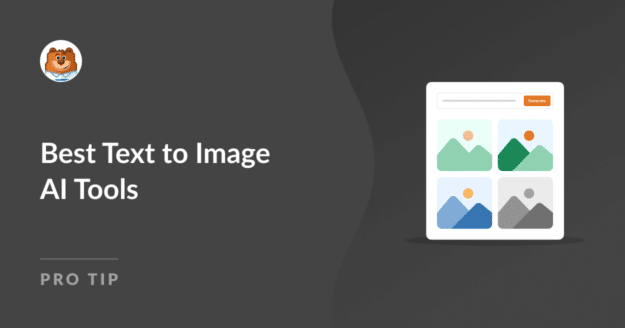AI Summary
With the powerful and ever-evolving text-to-image AI tools we have today, turning words into creative artwork is a cakewalk. Text-to-image generation is so accessible now, that if you are searching for a particular image on Google, chances are, it will be easier for you to generate it using an AI art generator.
Generating images and digital artwork with AI is one of my favorite AI applications. I have been using and playing with dozens of AI tools recently, and interestingly, they can be very different from one another.
Now, we don’t need to understand the technical chops like the learning model behind every tool. But if you are planning to generate some artwork for yourself, it is ideal to know the best text-to-image AI tools in the market.
I have spent countless hours testing and experimenting with different text-to-image AI tools, and I have consolidated all of my findings here in this article. So let’s dive in!
Text-to-Image AI Tools I Recommend
- 1. Adobe Firefly
- 2. Grok 2
- 3. Midjourney
- 4. DALL-E
- 5. Image Creator by Microsoft Designer
- 6. Canva Magic Design AI
- 7. DreamStudio (Stable Diffusion)
- 8. NightCafe
- 9. Meta AI
1. Adobe Firefly
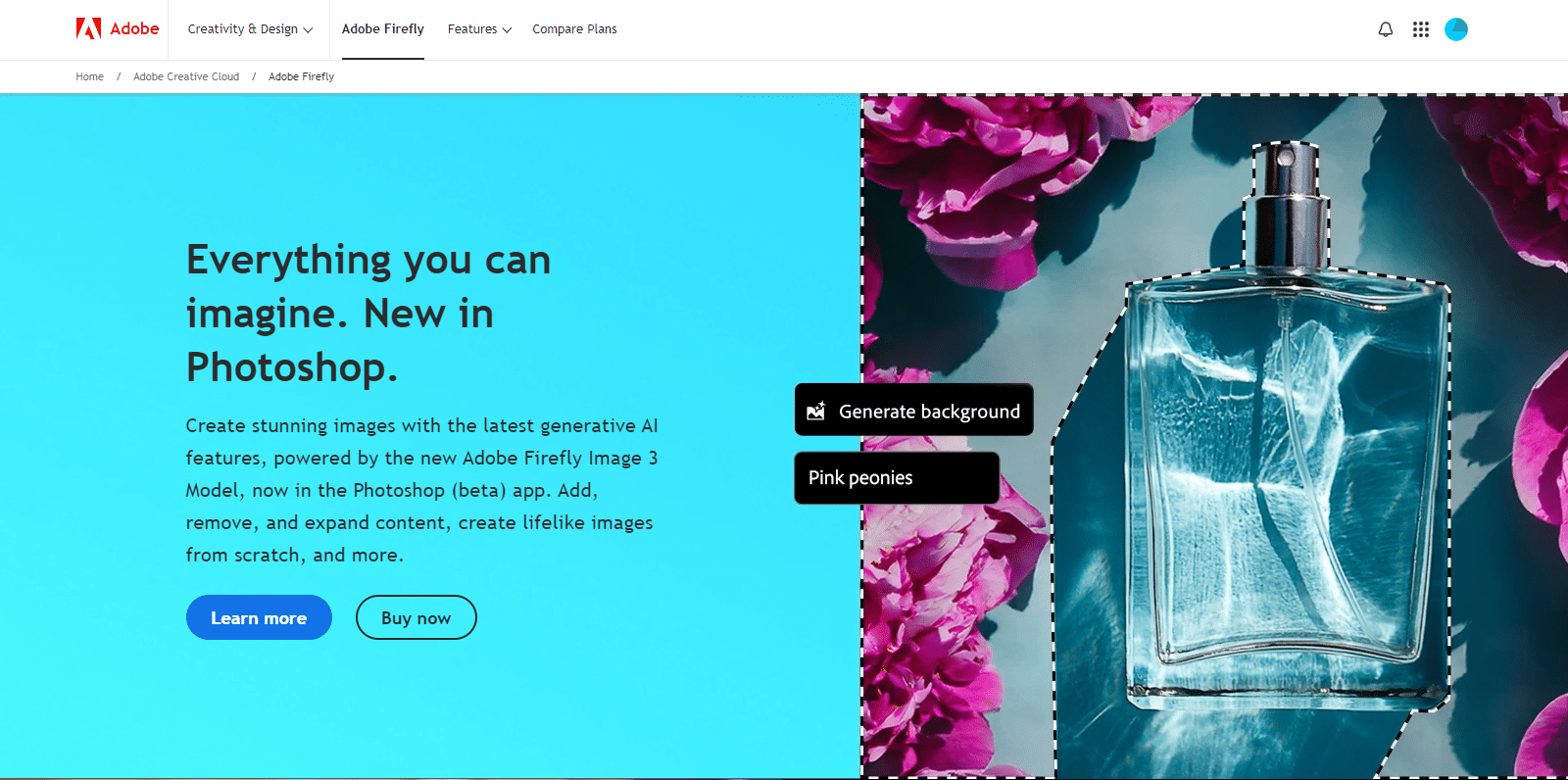
Adobe has always been ahead when it comes to creating tools for media and editing so there’s no surprise for them to have one of the most advanced text-to-image AI tools.
The reason I consider it to be one of the most powerful tools is that it is also baked right into its existing suite of editing tools. The level of granular controls you get with Adobe Firefly makes image creation more accurate and easy to customize.
If you want to try Adobe Firefly, you can visit the Adobe Firefly website. This way, you can test out the image generation without downloading any Adobe tools like Photoshop or Illustrator.
A particular feature that I found interesting was Generative Fill. With this feature, you can select a particular area in your image and ask Firefly to replace it with anything by giving a standard text prompt.
Aside from the quality and image generation results, what’s great about Adobe Firefly is that every image created using the tool is safe for commercial usage. “Trained on Adobe Stock images, openly licensed content, and public domain content, Firefly is designed to be safe for commercial use,” Adobe says.
My experience with Firefly was pretty great. I was always able to get the image to look how I wanted it to be by giving follow-up text prompts or by using the image customization options available with Firefly.
I asked Adobe Firefly to generate an image for this blog post and the result was pretty good. This image was generated just from the blog title “Best Text to Image AI Tools”.
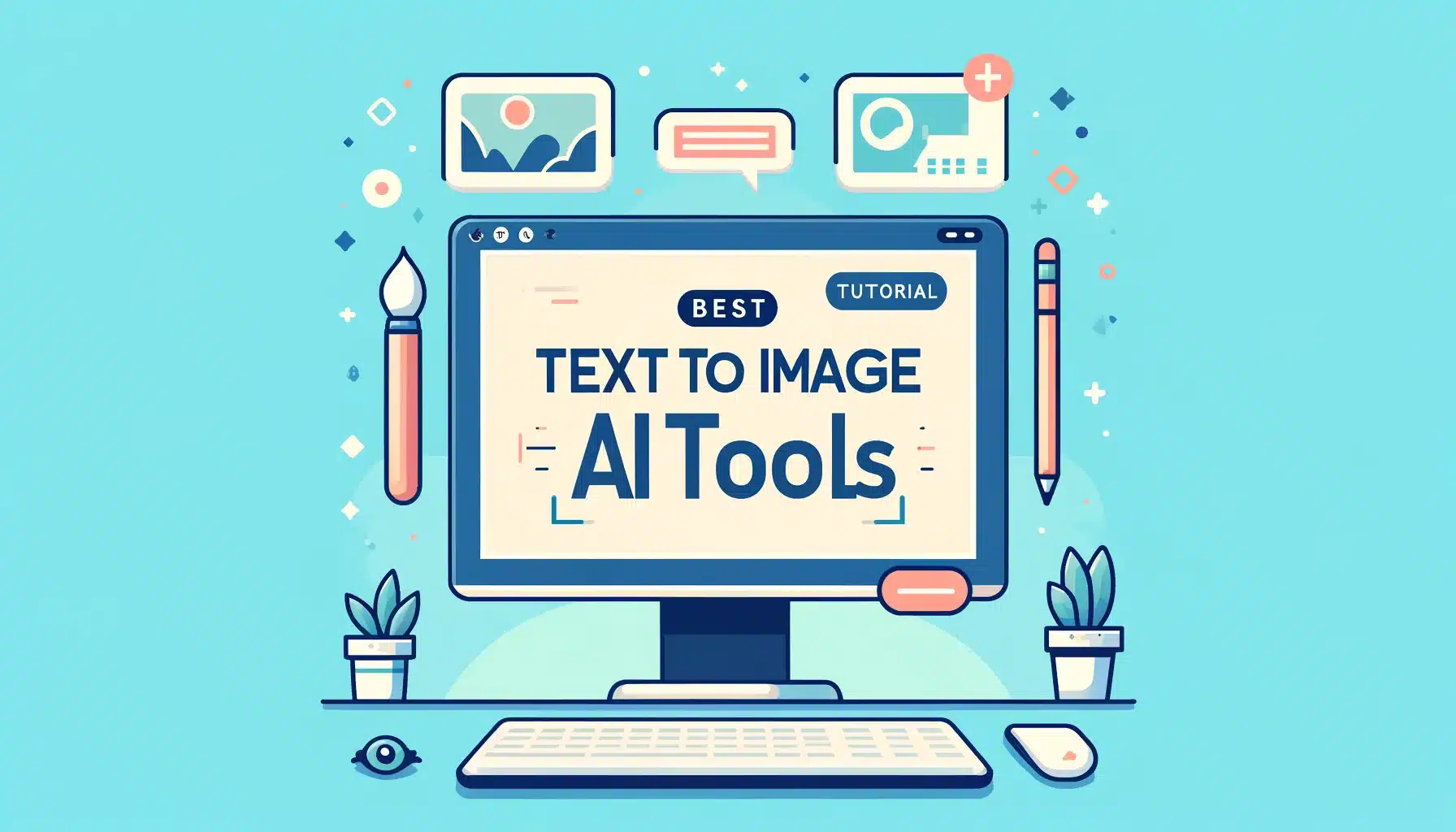
We even used Firefly to generate creatives to promote our recent WPForms birthday sale. Could you tell that this was an AI-generated image?

Adobe Firefly pricing: Adobe Firefly has a free version that gives you 25 free credits each month. The paid plan starts at $4.99 per month and gives you more credits.
2. Grok 2
I just had to update this article when I saw how good the image generator is in Grok 2.
If you’re not familiar with this tool yet, you’ll find it inside your X app (the social network formerly known as Twitter).
I asked it to generate a couple of versions of our WPForms mascot, Sullie, from a text prompt. The results were great. Sure, they don’t look exactly like Sullie, but this is the only tool I tried that was able to correctly add the form to his shirt.
Prompt: Create a Pixar style image of a smiling brown bear with his mouth closed. He has a tuft of hair on the top of his head. He's wearing a white shirt that is mainly white on his body. His shirt has an illustration of an online form on the front in blue.
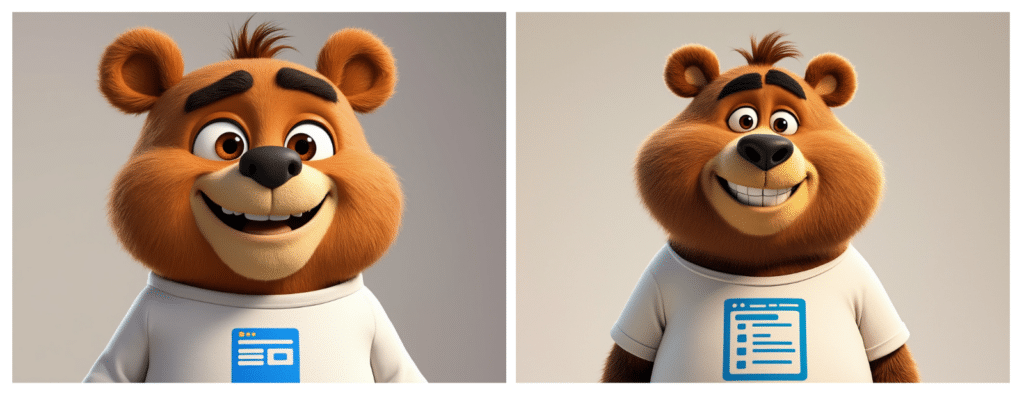
Also read: Practical AI prompt examples
don’t like the fact that Grok 2 is built into the X app. It’s not super convenient; X is definitely not top of mind when I’m generating images at work.
But that’s the only way to use it in the UK, where I live—at least for now.
Grok 2 has raised some eyebrows for violating copyright and producing images that other models wouldn’t create. Bias and legal issues are still a problem for LLMs, so it’s not alone.
One thing’s for sure, though: it’s incredibly fast.
Grok 2 pricing: You can access Grok 2 using X Premium, which has a monthly fee of $8 in the US, £8 in the UK, and ₹650.00 in India.
3. Midjourney
If you have been looking at and comparing different text-to-image AI tools, you must have heard of Midjourney.
The tool gained massive popularity with its photo-realistic results. If you have not used Midjourney, this might come as a surprise. Midjourney is not a standalone tool but rather a bot for Discord, a communication app.
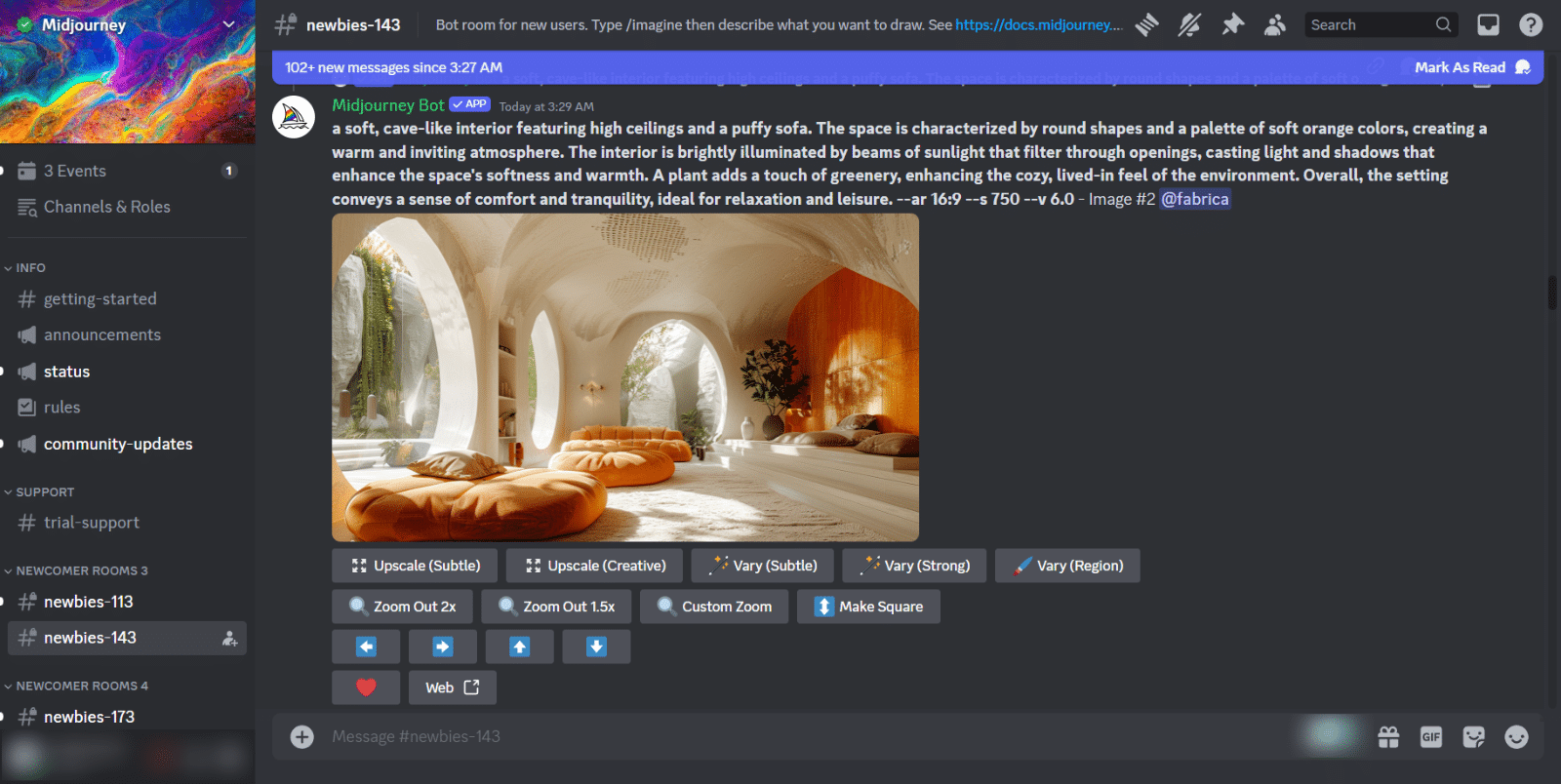
So, how do you use Midjourney? To use Midjourney, you first need to sign up on their website and then log in to their Discord server.
If you have never used Discord before, it might get a little confusing at first. I suggest looking around on different channels and once you are comfortable, go to the “Newbie channel” and start generating by entering the bot command /imagine and typing in the text prompt for your image.
What I liked about Midjourney is that it comes with a very strong community around it. You can go to any channel like “Newbie” and see how others are engineering/tweaking and using their text input. You can ask community members any questions you might have and also give support wherever possible.
I tested out a sample text prompt to generate a realistic image, and the results were pretty good!
Prompt: Three cacti in a European hostel. They are sitting on a desk in the middle of the hostel reception.
And, here is the result:

Midjourney pricing: You can access Midjourney using Discord rooms/channels for free, but they can be pretty crowded and limited. Paid plans start at $10 per month.
4. DALL-E
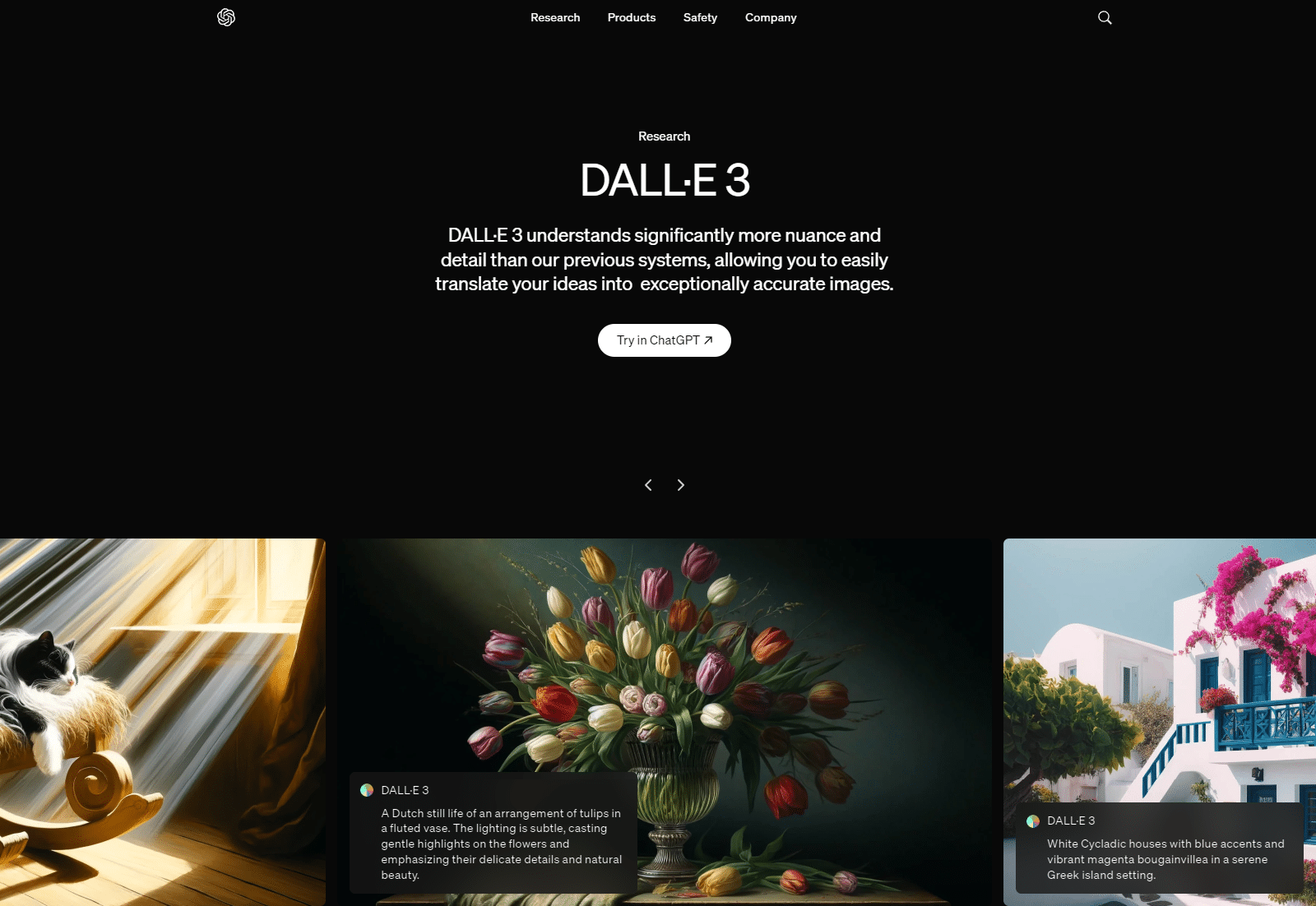
DALL-E 3 is a more advanced and improved version of DALL-E 2, which was one of the viral tools for image generation in the initial days. Being a part of the OpenAI suite of tools, DALL-E 3 works on top of ChatGPT 4.
DALL-E 3 is based on a much more complex language AI model and is capable of generating more detailed images. Also, since this tool is a premium offering, you can expect it to be faster than its competition.
For every prompt, DALL-E generates four unique images, and you can give follow-up prompts to tweak the ai-generated art or images. Alternatively, you can ask it to generate new images if you are not satisfied with the output.
You can also view and modify the prompts as ChatGPT goes into more detail to generate the image.
For example, here is a simple prompt I provided to DALL-E 3.
Prompt: Create a Pixar style photo of a brown bear sitting in an office and sending emails.
Here is the result:
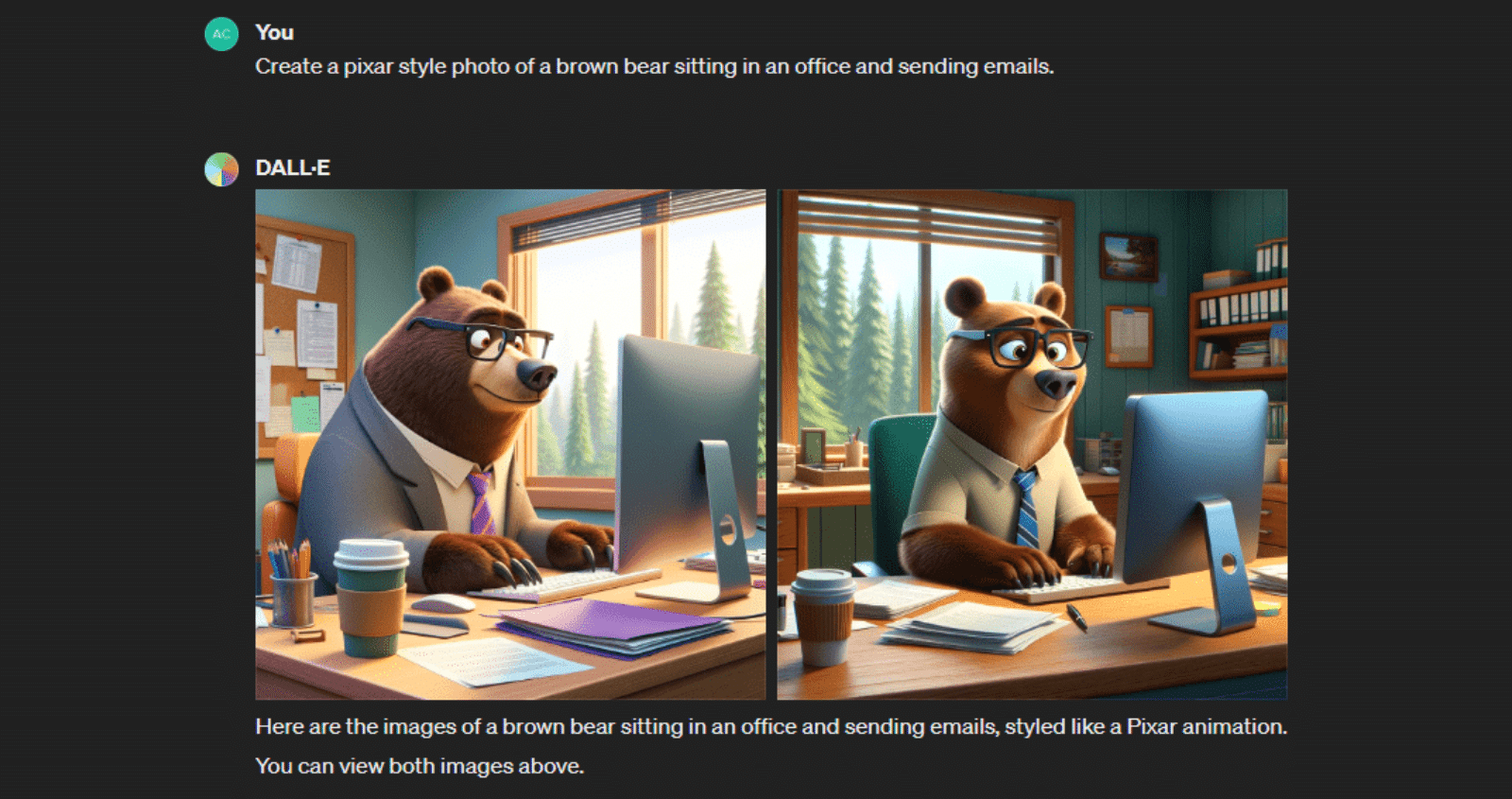
But here’s the actual and more detailed prompt used by ChatGPT:
Prompt: A Pixar-style animation image of a brown bear sitting at an office desk, focused on typing an email on a modern computer. The office setting includes a window with a view of a forest, a coffee cup, and scattered papers on the desk. The bear appears intelligent and slightly humorous, wearing glasses and a tie. The environment is colorful and friendly, typical of animated family movies.
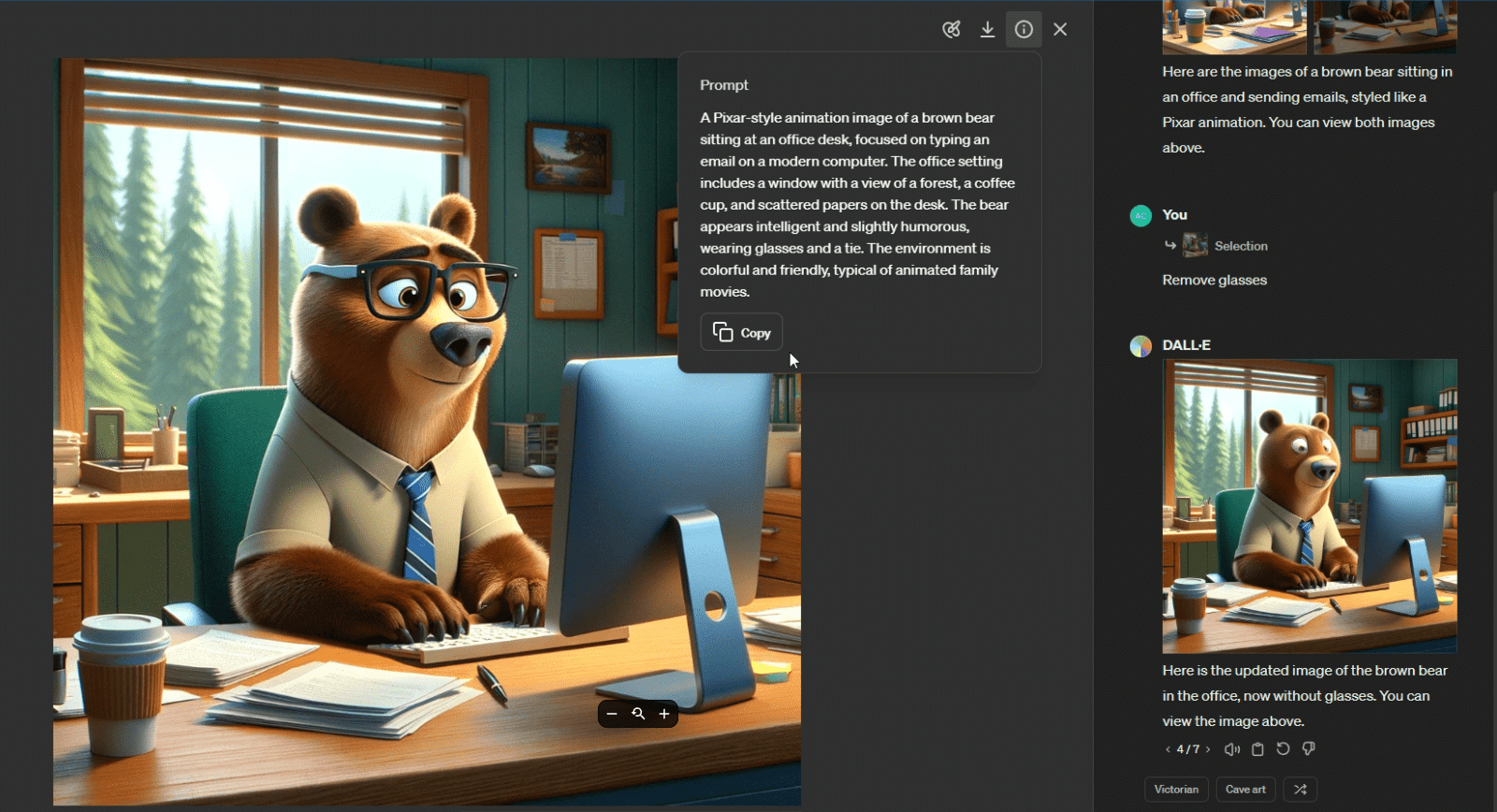
If you like an image output and want to tweak the prompt, you can copy and tweak it to any other look.
Alternatively, you can use the select tool to selectively alter part of the image. For instance, I don’t want the bear to have glasses so I will select the area and ask it to “Remove glasses”. And Voila!
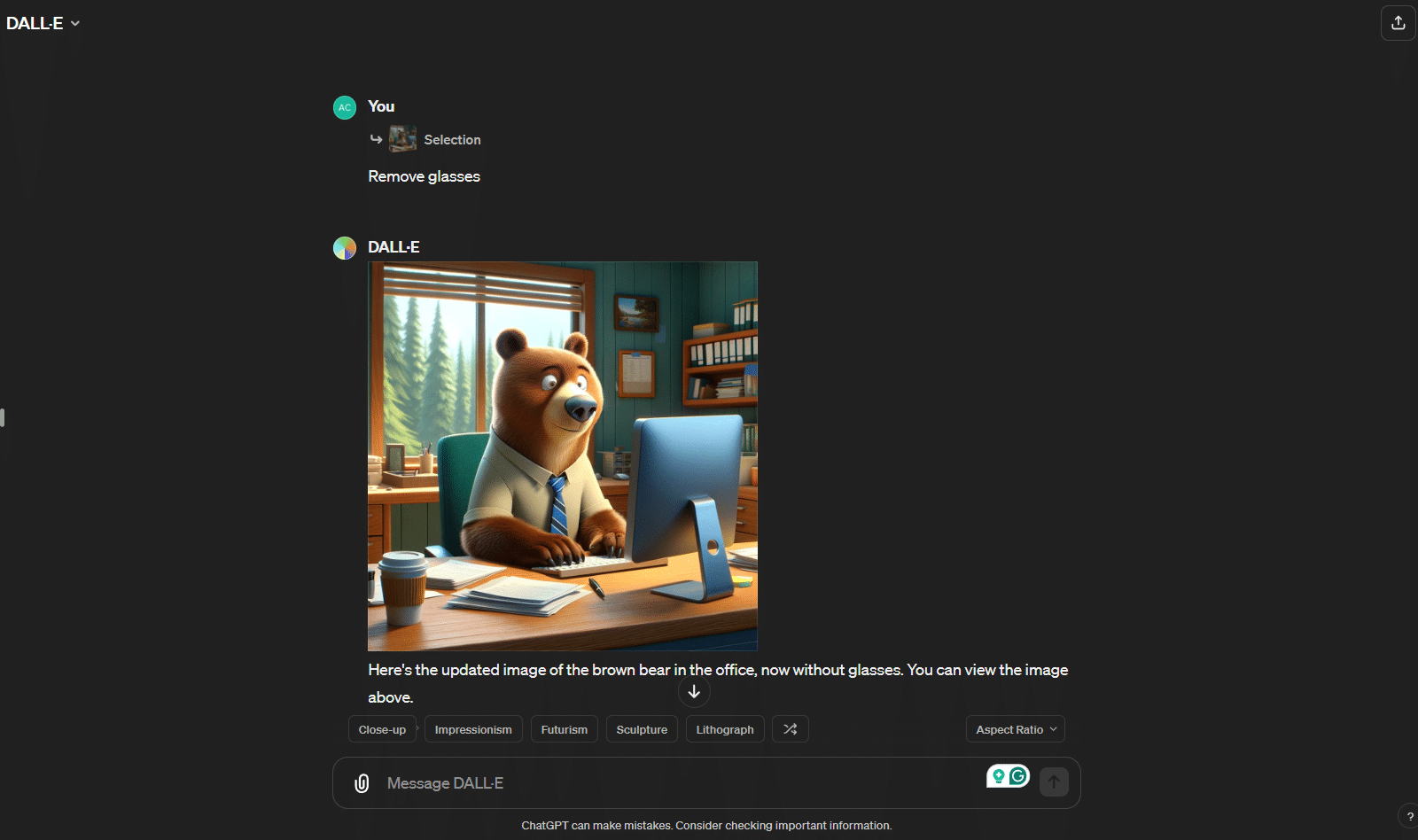
I had to ask DALL-E 3 to regenerate it several times, but the final result was really good.
If you already have access to ChatGPT Plus or are planning to get it, access to DALL-E 3 makes it much more lucrative.
DALL-E 3 pricing: You don’t need to pay for DALL-E 3 separately, as it comes with a ChatGPT Plus subscription for $20 per month.
Pro Tip
Did you know that you can create images based on the content of a form entry? For example, you could get your visitors to specify colors and content and have DALL-E generate an illustration. Check out the full list of WPForms AI integrations to learn more!
5. Image Creator by Microsoft Designer
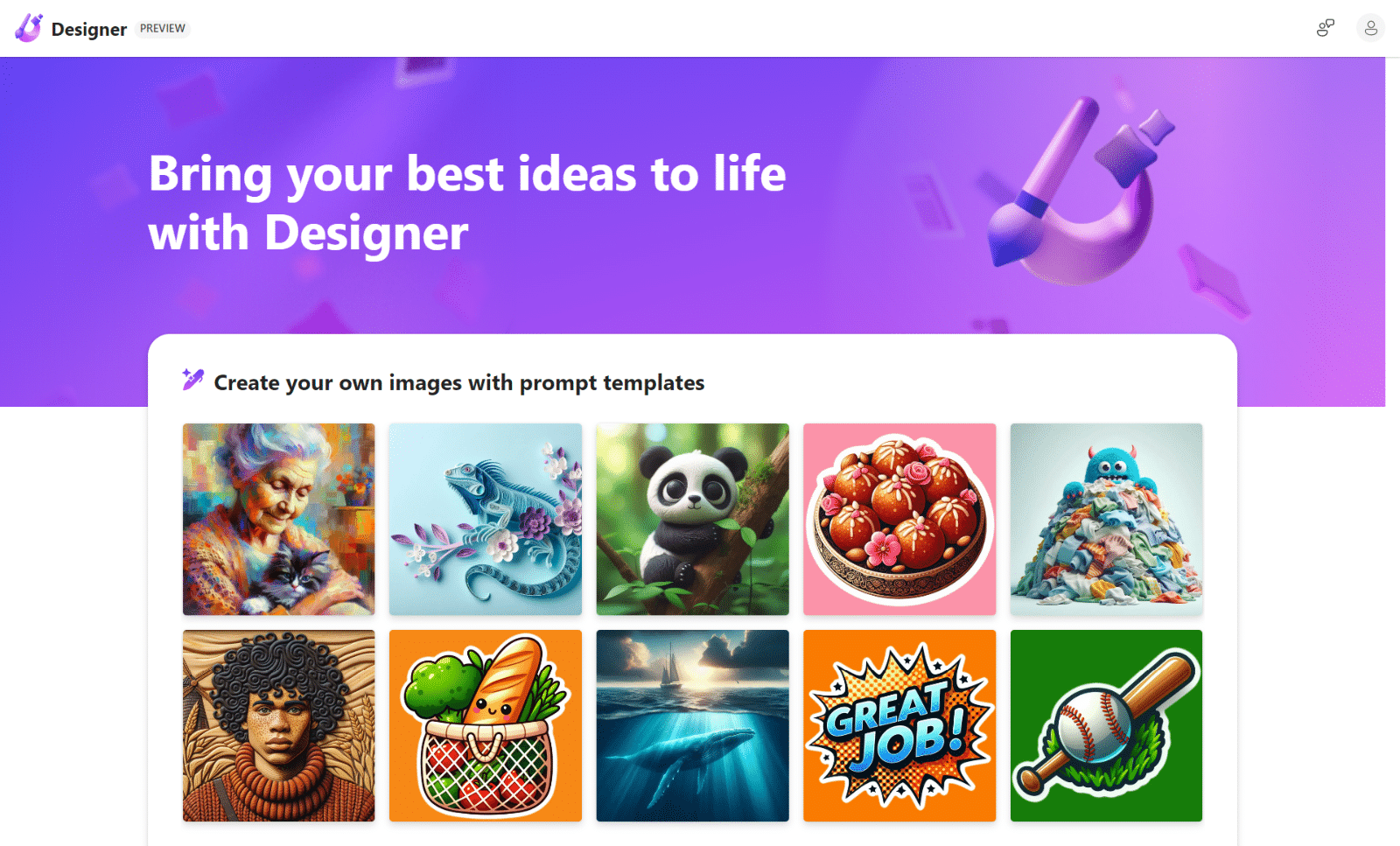
Image Creator by Microsoft Designer is built on top of DALL E 3, the most advanced AI image-generation model by OpenAI. It comes bundled with Microsoft’s Copilot AI tool.
Like most AI tools listed here, it comes with a chat interface that you can use to generate images and provide follow-up prompts to tweak those AI-generated images. The tool also suggests relevant changes that make image generation a lot easier.
Here is a simple prompt I tried:
Prompt: "Create an image of a cute puppy floating in space wearing a space suit."
And, here is the result:
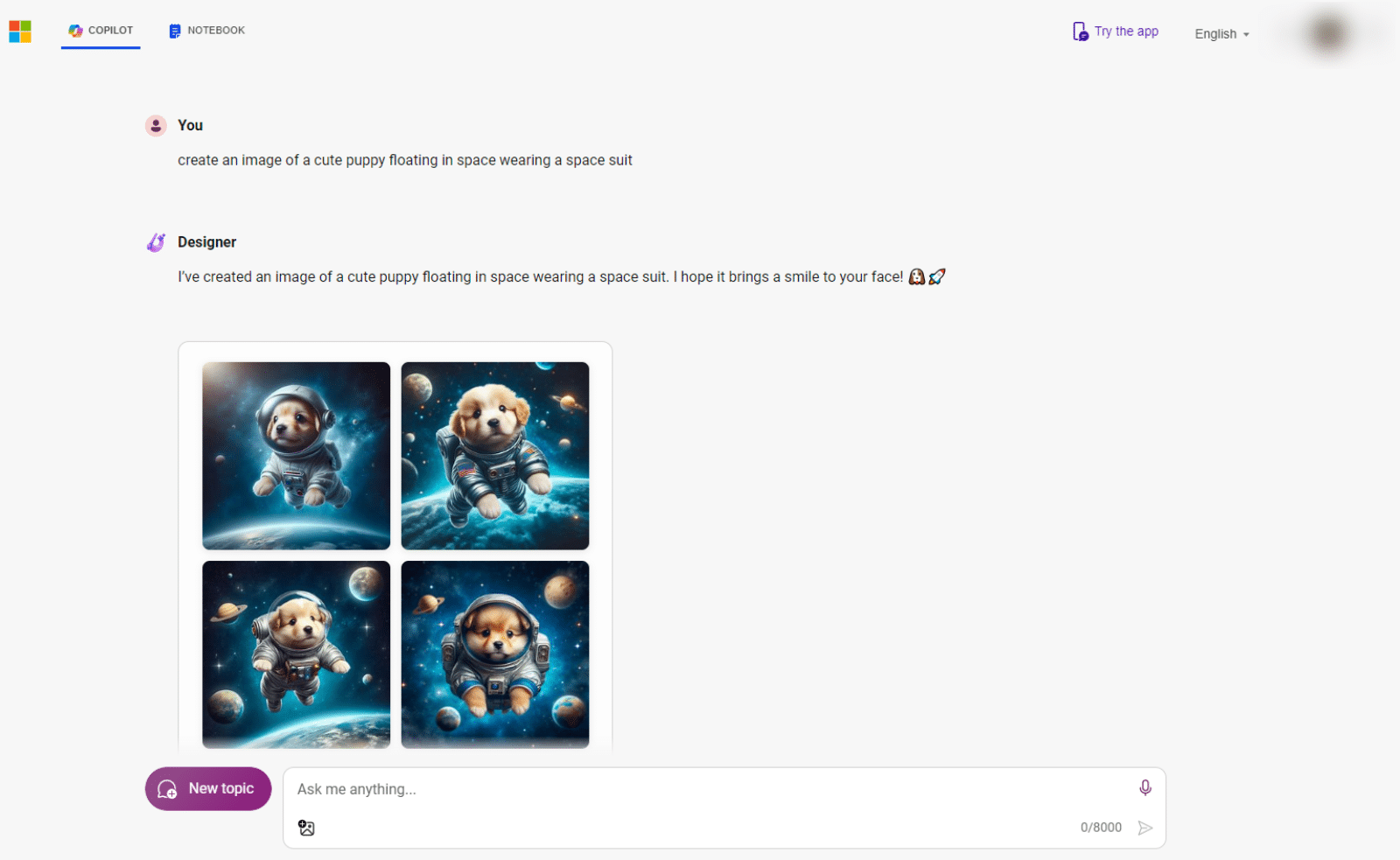
You can also select areas of the image to regenerate by selecting the area and giving a follow-up prompt.
What I like about this tool is that you can pick a design and move to Microsoft Designer to edit the image further. Here, you get all the basic and advanced image editing tools you will need to finish your artwork.
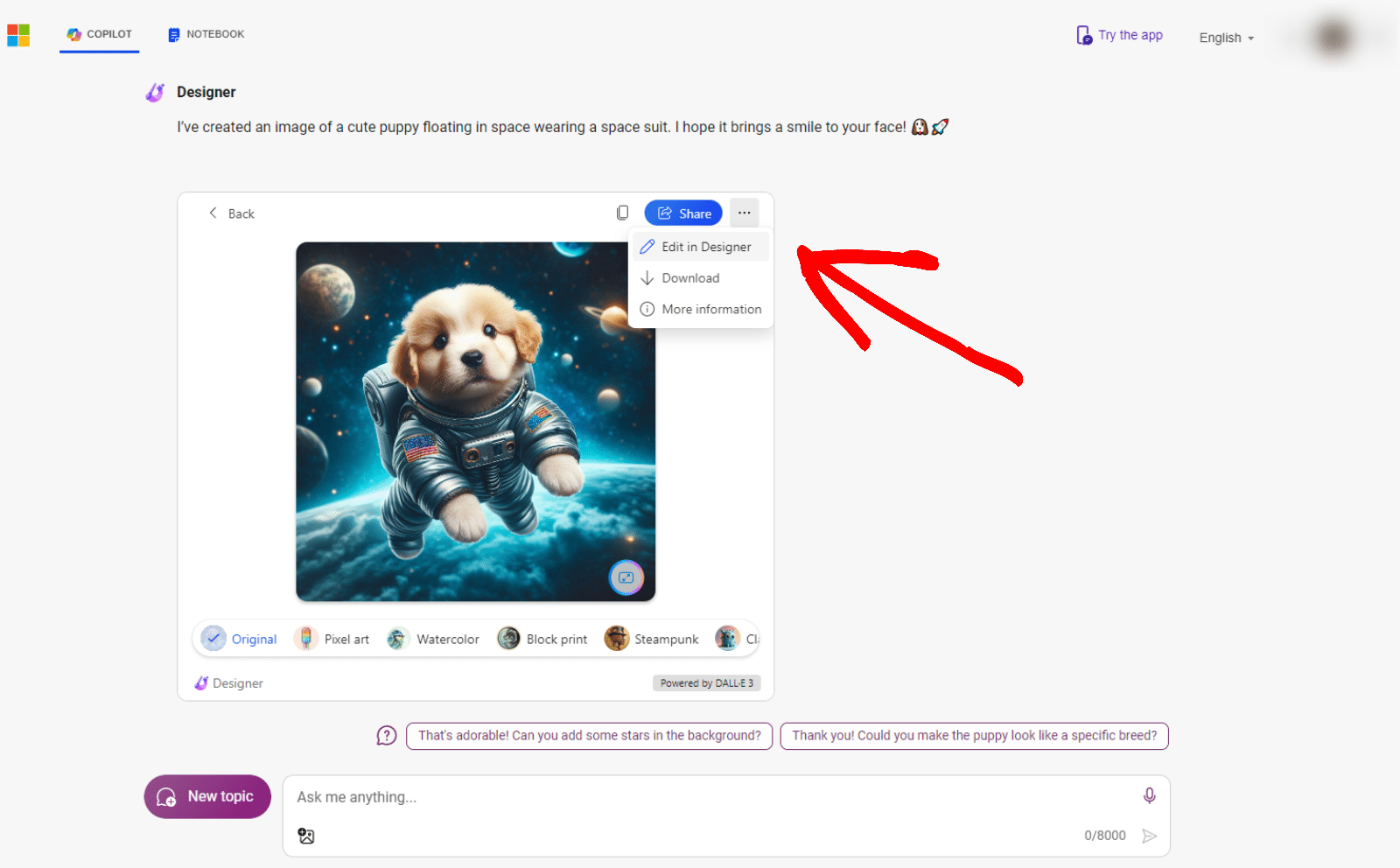
Microsoft Designer pricing: There is free access for all registered Microsoft users, so it’s a great way to play around with DALL-E without the limits of a free ChatGPT account. You can also go with the pro plan for Designer, which offers priority access to GPT-4 Turbo and 100 daily boosts with Designer for $20/month.
6. Canva Magic Design AI
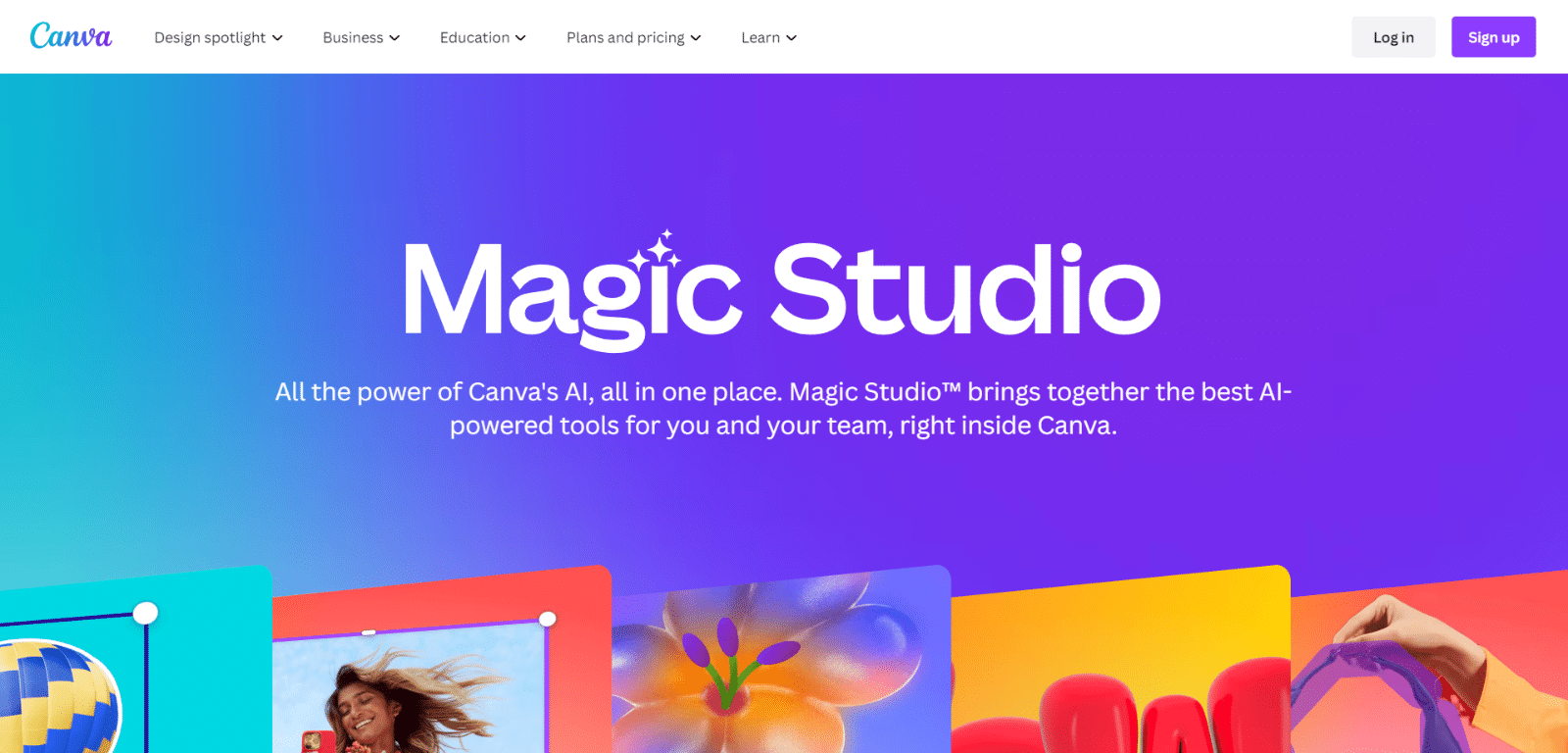
Canva is one of the most popular solutions for seamlessly creating online design assets for various use cases like social media, websites, or any other graphic design. Undoubtedly, it is my go-to tool for creating images for the blog or any design need. Being the most user-friendly and innovative online graphic design tool, Canva jumped into the AI race and announced its version of the text-to-image AI generator.
However, unlike most of Canva’s lucrative features, the AI image generator is not barred behind its paid plans. You can access it simply by logging in to your free account and going to Canva AI generator.
To use the tool, you need to open a new or existing Canva design. Go to the Magic Media tab and write your prompt in the image section. You can also create graphics and videos from the Magic Media video generator tab.
Just like a few of the other tools mentioned here, having the image generator baked right into the image editing tool gives you a lot more freedom to further work on the image. This undoubtedly gives Canva an edge over other tools.
I asked Canva Magic Media to generate a logo for a sneaker shop order form while explaining the attributes of the logo, and the results were pretty good.
Prompt: Create a minimal logo with a flat design for an online sneaker store.
And this was the result:
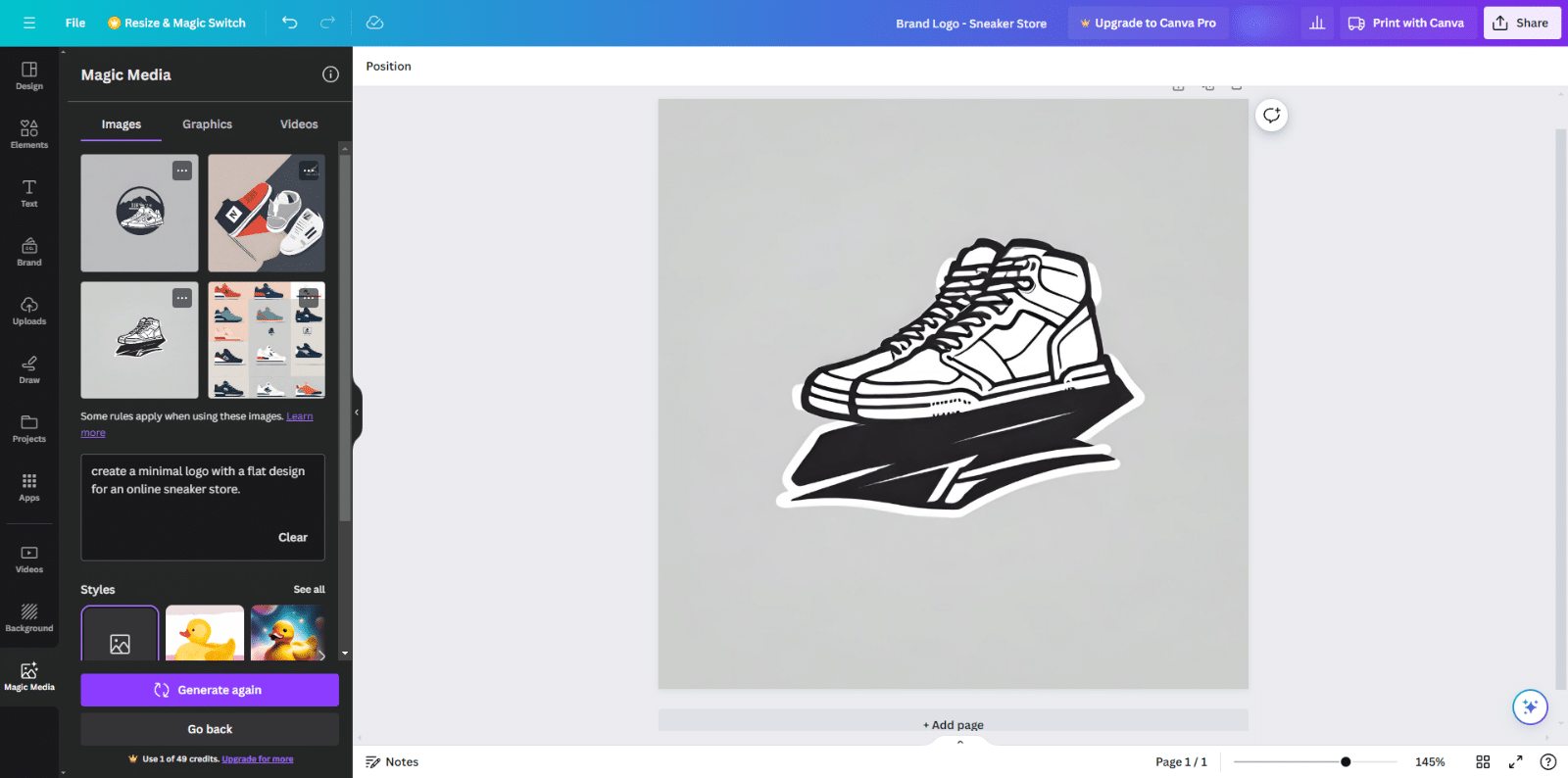
You can use these generated images anywhere on your website or marketing material. I added the logo on the order form to create a customized branded form, and this was the result:
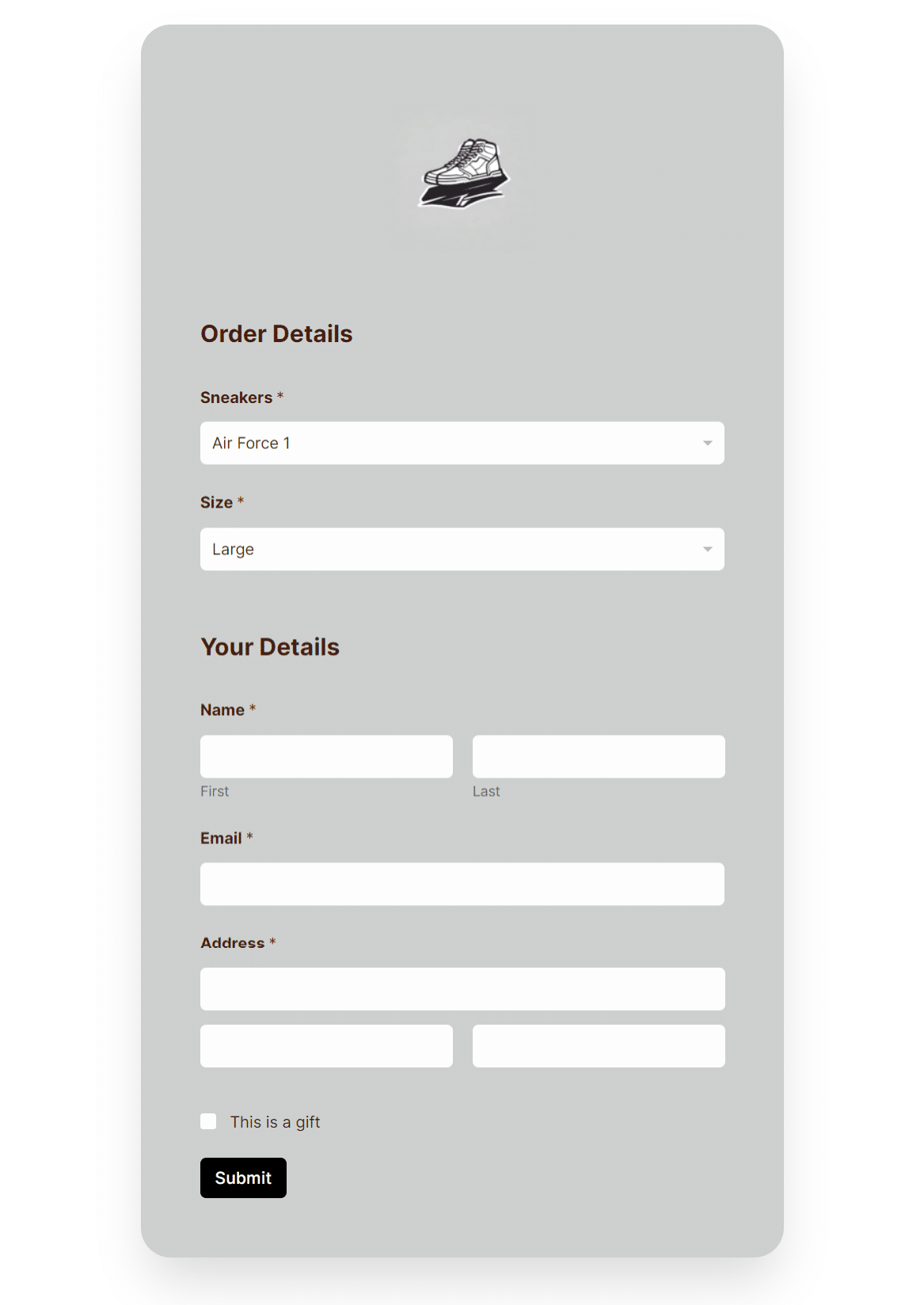
Canva AI Image Generator pricing: With the Free plan, you get 50 credits per month. Each image generation and regeneration costs 1 credit. With the paid plans, you get 500 credits per month.
7. DreamStudio (Stable Diffusion)
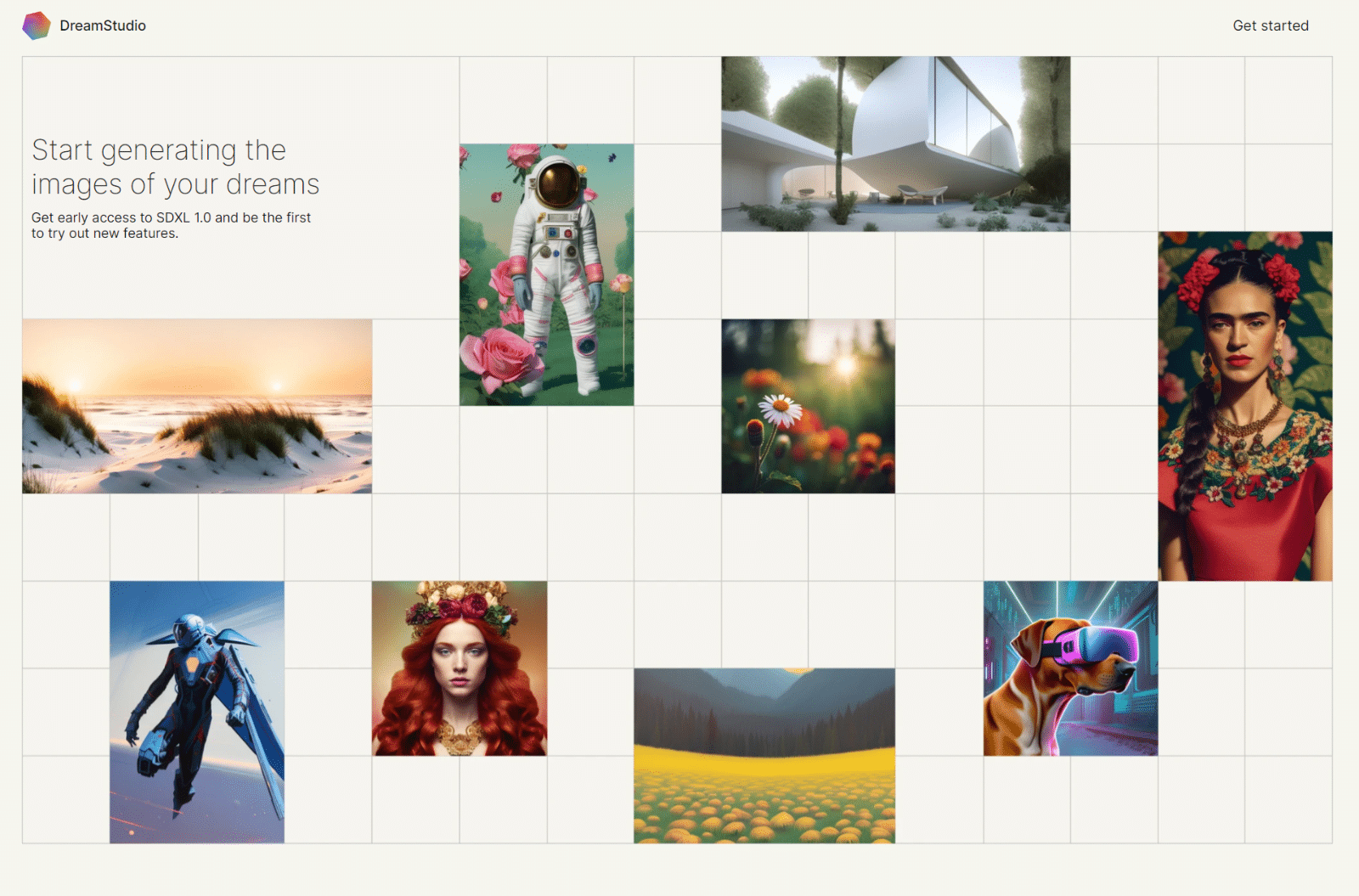
Designed by the Stability AI developer platform, DreamStudio is yet another powerful AI image generation tool. If you have heard of Stable Diffusion and are not sure about the difference, they are essentially the same tools with the same base AI model designed by stability.ai.
What sets it apart is that this particular tool is that it is open-source and is rapidly getting better and more efficient.
It comes with loads of image customization features, too. My experience with DreamStudio has been a breeze. It almost always captured the idea of the image perfectly, with very impressive results.
For instance, I asked DreamStudio to generate an image for the purchase success message for a product wholesale order form.
Prompt: Create a thank you banner for a purchase confirmation email for my online sneaker store.
And DreamStudio generated some great images.
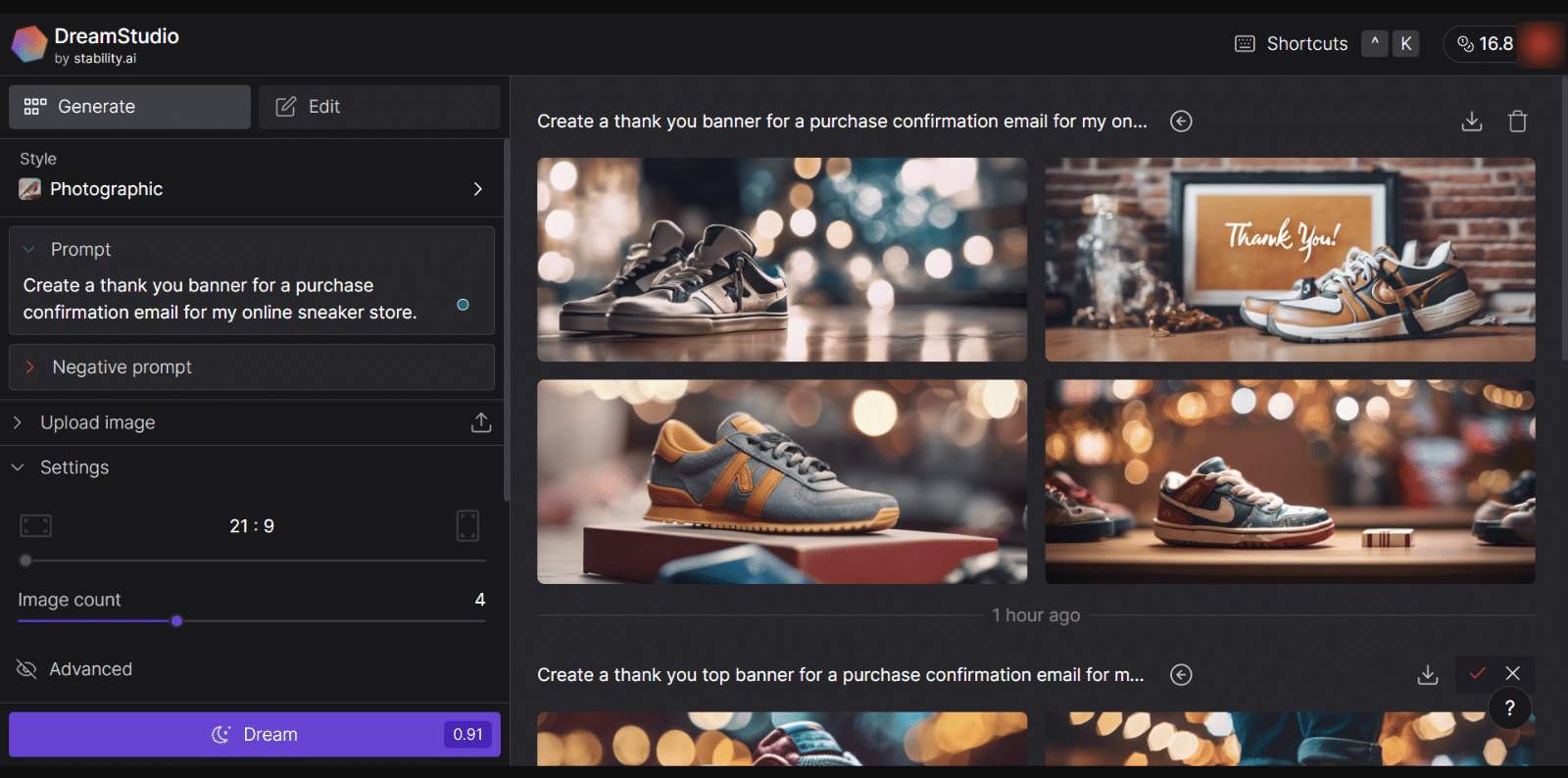
Although the common factor was that DreamStudio was struggling with the text “Thank You”, one image worked out for me. I added the image to the purchase confirmation thank you page and this was the result:
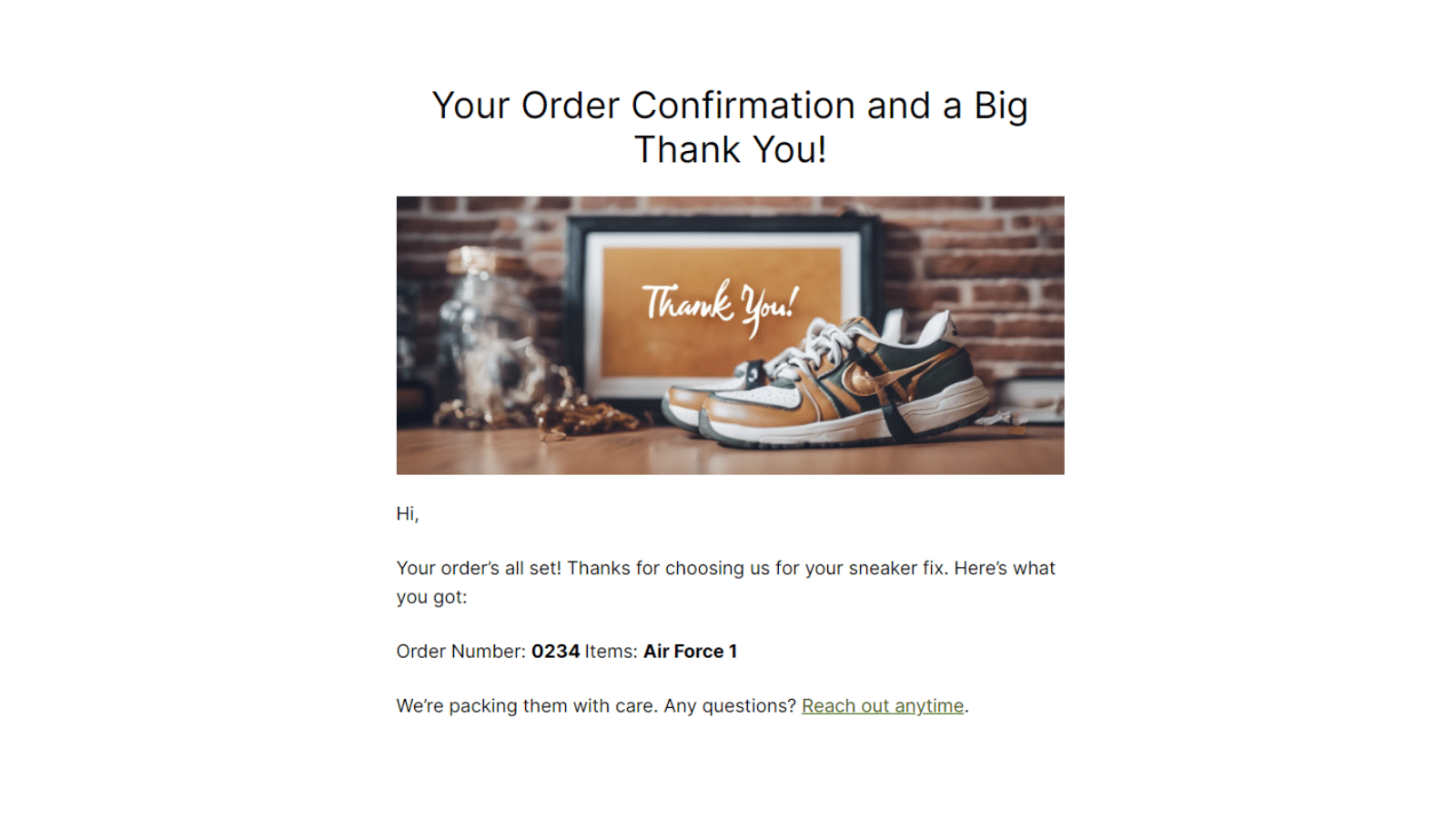
If you like granular controls, DreamStudio lets you choose the style of your image, set width and height, add a negative prompt, choose the number of images to be generated, and even lets you add the seed to generate similar images.
DreamStudio pricing: DreamStudio operates on a pay-per-use model. You get 25 free initial credits, and then you can purchase 1,000 credits for $10, which is enough to generate around 5,000 SDXL 1.0 images.
8. NightCafe
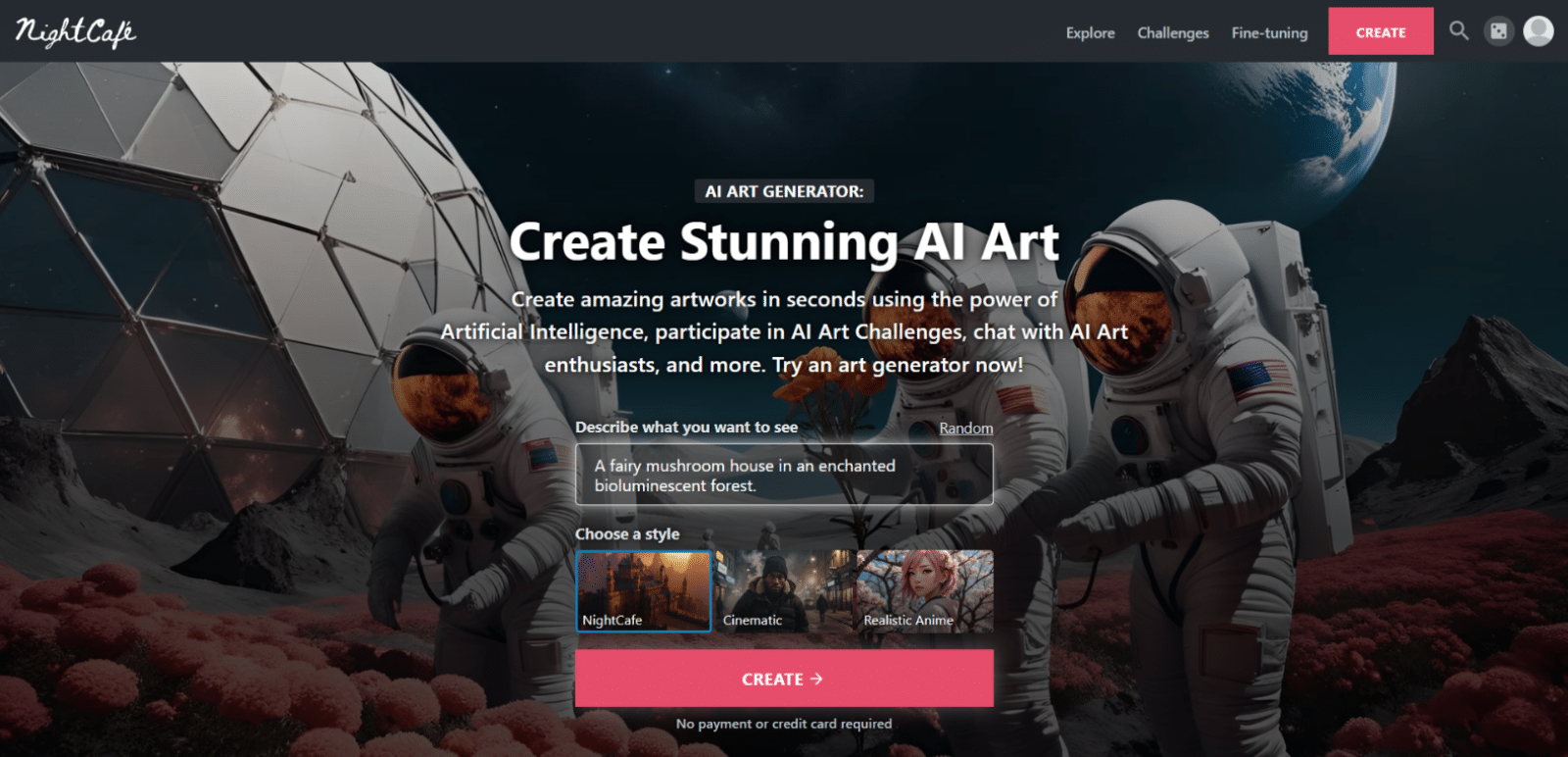
NightCafe is an impressive AI image generator designed with a focus on art and community at its core. NigtCafe focuses on generating all sorts of digital art such as mythical landscapes, art pieces, imaginary creatures, realistic portraits, and whatnot.
If you aim to use AI for creative and imaginative image generation, then NightCafe is perfect. The tool comes with multiple editing options to help you further fine-tune your artwork. You can adjust the seed, prompt, AI model, aspect ratio, art style (such as ‘anime avatars’), or algorithm to generate your artwork.
You get more than 25 stable diffusion models to work with. I tested it out with most of the DALL E and stable diffusion AI models to generate some artwork using the artwork generator, and I was pretty impressed with the results.
Prompt: A detailed and cute image of a smiling bear holding a spatula and wearing a cooking apron.
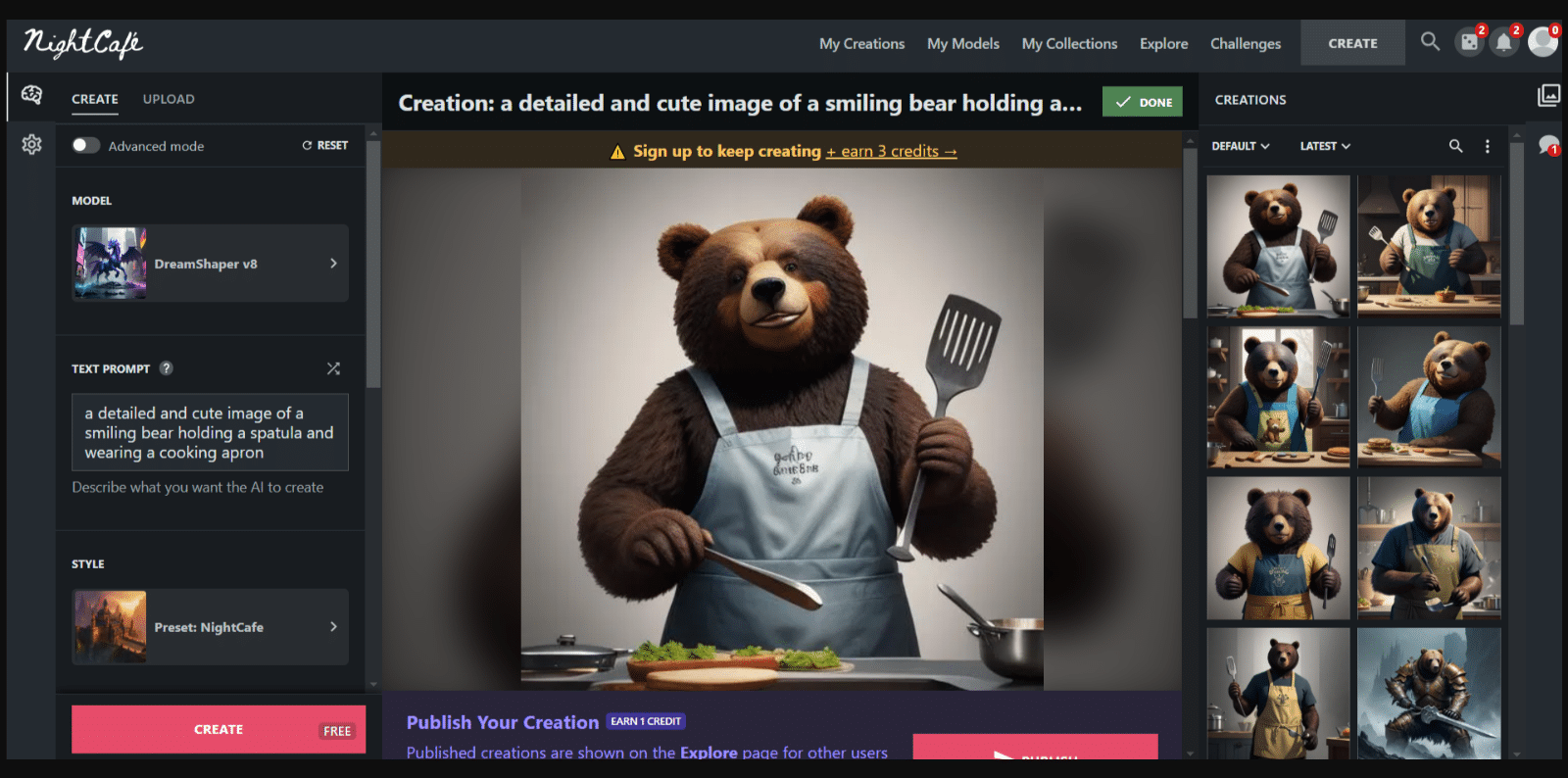
You can also spot some of the other variations I generated on the right sidebar in the image.
Apart from the image generation features, NightCafe has many community benefits. With regular ongoing art contests, pre-designed templates, community showcases, and publicly available artworks from other creators, this text-to-image AI platform is also a place to grow your skills by learning and collaborating with other artists and creators.
NightCafe pricing: NightCafe has a free version with limited features and a few free credits. Paid plans start from $5.99/month and come with 100 AI photo credits per month.
9. Meta AI
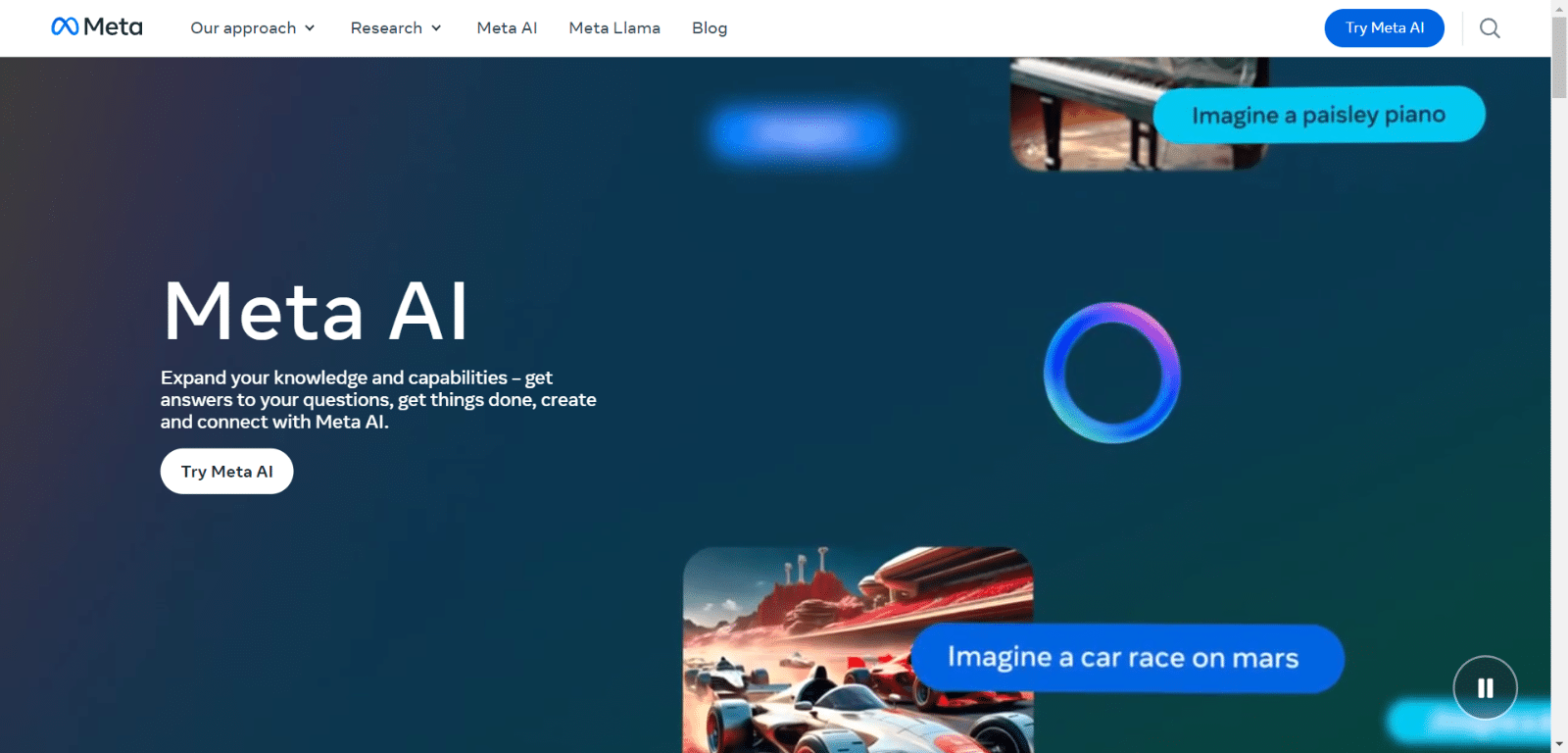
The Company behind Facebook and WhatsApp, Meta, launched their own version of a free AI chatbot in April 2024.
The tool is essentially a response to ChatGPT but Meta is baked right into its apps which can help you streamline a lot of tasks using AI such as planning social media posts or calendars or asking it to generate an image to go with your status.
Meta AI is still rolling out and is not available to all regions, but if you have access to it, you can use it with any of the Meta apps like Facebook, Instagram, and WhatsApp.
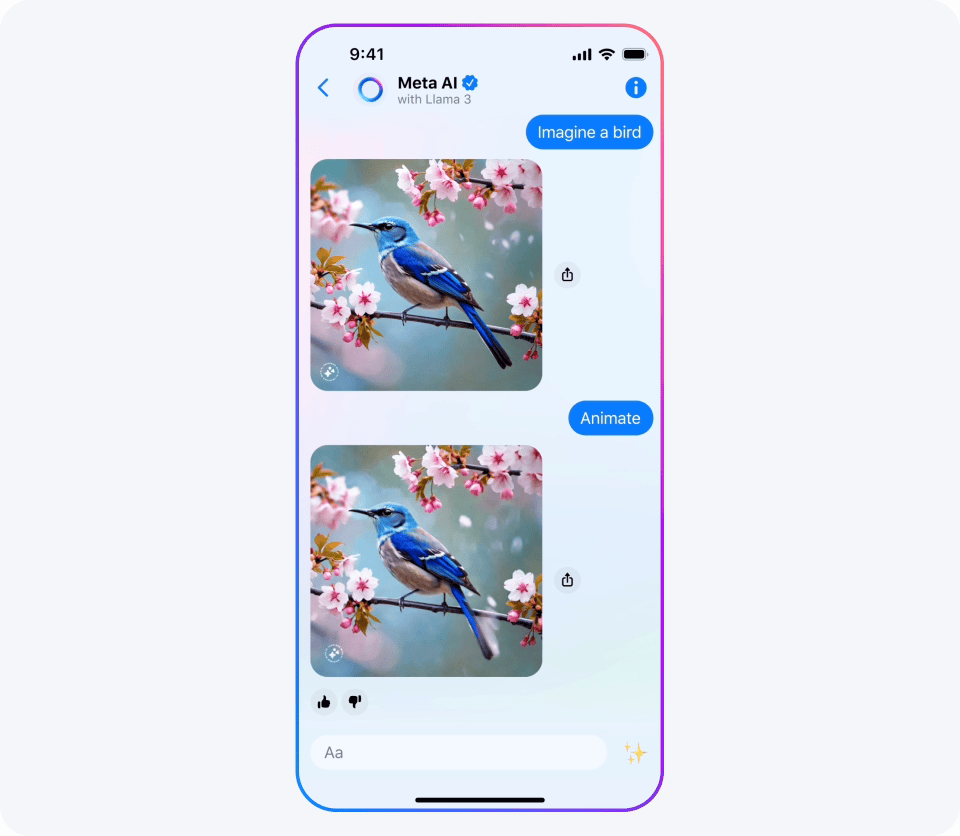
To generate images using Meta AI, simply go to Meta.ai and then click Imagine. There, you can type in your prompt, and Meta AI will generate four images simultaneously for you. You can reword your prompt or generate different images for your use case, just like other text-to-image AI tools.
The only downside is that all images will have a watermark “Imagined with AI”. However, this does not mean you cannot use the images commercially.
Meta AI pricing: Free
And that’s it! Now you know about the best AI image generation tools.
FAQs on the Best Text-to-Image AI tools
Here are some common questions about text-to-image AI generators.
What is an AI text-to-image tool?
Ttext-to-image AI tools use artificial Intelligence (AI) to create visual assets by following the prompt instructions from the user. The generated image follows the prompt and the language model to create images. These tools are designed to automate the process of generating images, making it easier for users to create visual content without needing advanced graphic design skills.
How do AI image generators work?
AI image generators use deep machine learning algorithms trained on large language models to understand text descriptions and convert them into visual images. They process input text or the prompt, extract relevant features, and generate images pixel by pixel based on learned associations between text and visuals.
Which text-to-image AI tools are the best?
Determining the “best” text-to-image AI tools depends on your use case. Some of the most popular tools are DALL-E, Midjourney, DreamStudio, and Bing Image Creator. Each tool has its own unique features, strengths, and limitations, so it’s best to try out the free plans for all of them to see if the style of the image is suitable for your project.
Can I generate AI images for free?
Absolutely! There are various text-to-image AI tools available for free. I like to use DALL-E through Microsoft Designer.
Some free tools have limitations on usage or features. For example, some offer free trials or limited image credits, while others may operate on a freemium model. Freemium means that basic functionality is free, but premium features require payment. There are a few open-source projects that provide free access to text-to-image AI tools and models, but these may require technical expertise to set up and use.
Can I sell images made with AI?
Yes, in some cases. You’ll want to check the terms of service and licensing agreements of the specific AI text-to-image generator tool you’re using. Some tools may allow you to sell the images you create without restrictions, while others may have limitations or require you to purchase a paid license for commercial use.
Can I also generate audio and video with AI?
Yes, you can. We recommend tools like Synthesia. For example, you can integrate Synthesia with WPForms and create videos from form entry data.
Next, Power Up Your WordPress Website With AI
AI text-to-image generation is just one of the ways you can leverage this technology to scale up your website or business.
Want to learn about some creative ways to leverage AI for your WordPress website and beyond? Check out these detailed useful guides:
- How to Use AI Translation in WPForms
- Best AI Logo Generators
- Best ChatGPT Plugins for WordPress
- How to Add AI to Your Website
- Best AI SEO Tools for WordPress
- The Best AI Plugins for WordPress
If this article helped you out, please follow us on Facebook and Twitter for more free WordPress tutorials and guides.

